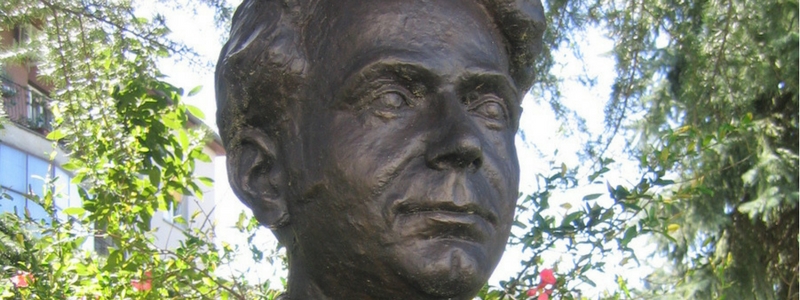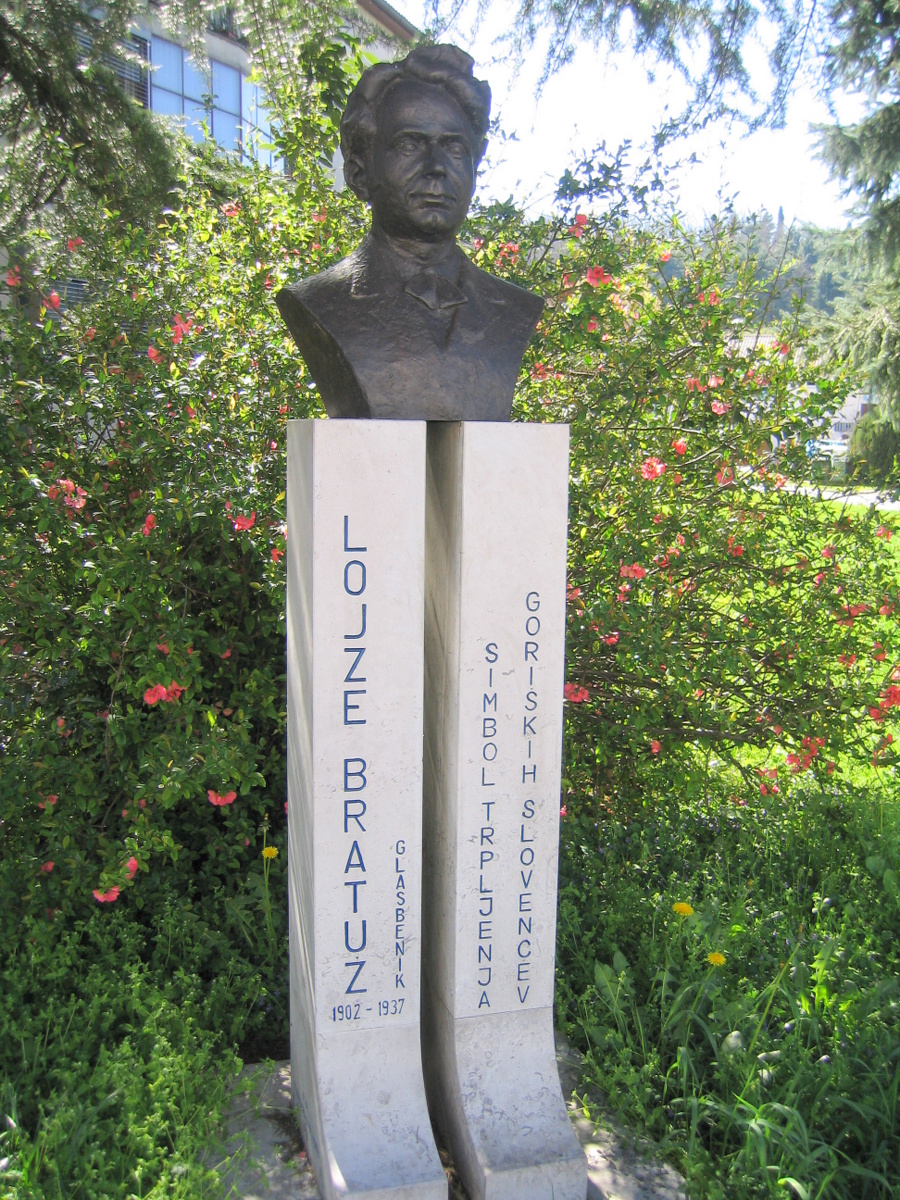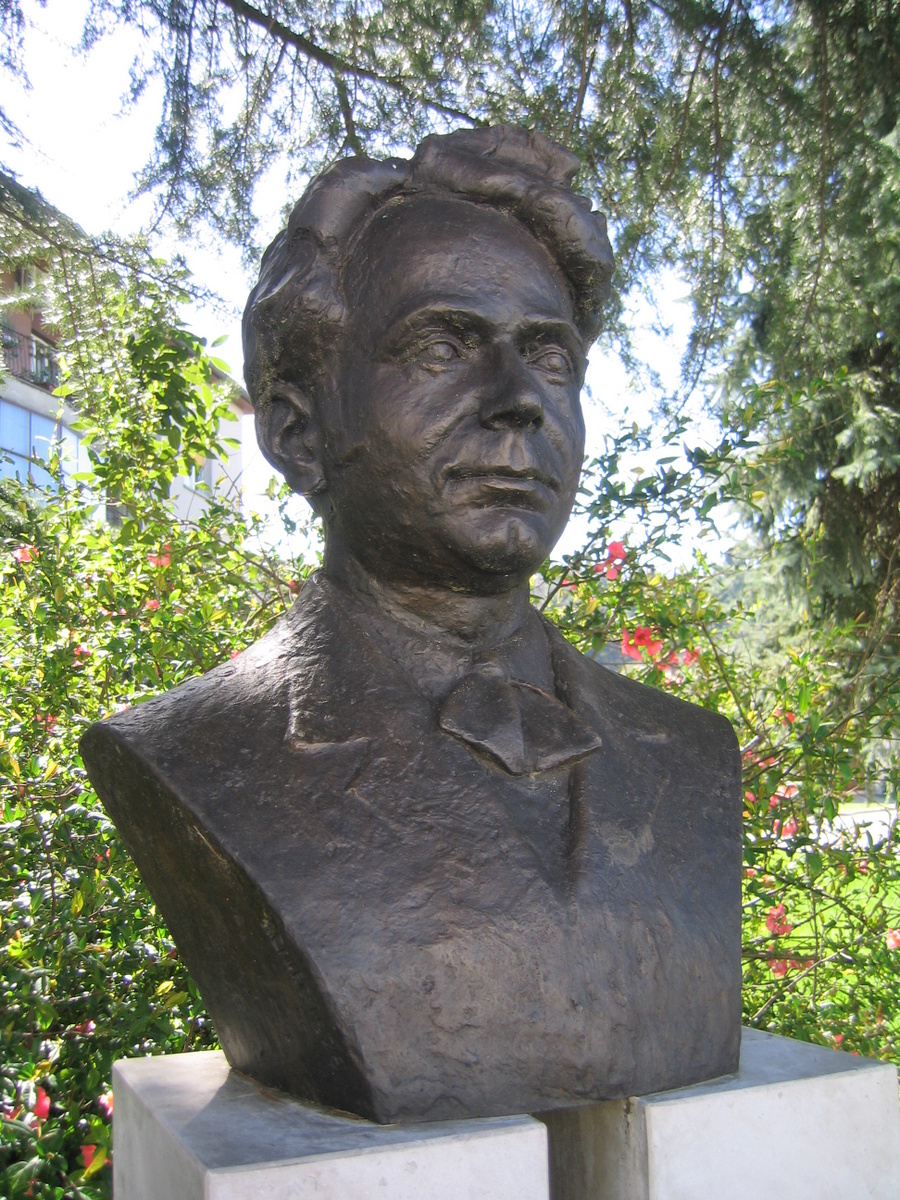Made by academy-trained sculptor Negovan Nemec, a sculpture dedicated to Lojze Bratuž was erected in 1978 in the Avenue of Notable Men on the initiative of the Club of Old Goriška Students.
Lojze Bratuž
A choirmaster, organist and composer from Goriška, Lojze Bratuž (1902–1937) is considered a martyr, having suffered a martyr’s death at the hands of the Fascists for the sake of patriotism and fostering Slovenian song.
He was born in Gorizia, where he attended primary school. World War I interrupted his early education, and in 1916 young Lojze and his family were forced to seek refuge from the war and flee their hometown. He lived in the Italian communes of Viareggio and Rotello for six months. After the war, Bratuž took a two-year teacher-training course and passed his secondary examination. He initially worked as a teacher in Šmartno near Kojsko, and then did his military service in Verona. In 1921, he gave several speeches at meetings in the run-up to the parliamentary elections. After 1922, he applied himself more extensively to music.
He conducted numerous choirs in the Goriška countryside, also accompanying them on the organ and leading them during church ceremonies. In 1929, Archbishop Franz Borgia Sedej offered him the post of music teacher at the Archiepiscopal Grammar School of the Gorizia minor seminary. Bratuž took the post, but was unable to stay there long, soon being imprisoned for patriotism. He left the seminary and found employment as a manager at the Societa Cecilia organ factory in Gorizia. In 1930, Archbishop Sedej appointed him supervisor of church choirs in Goriška; he was thus responsible for the only cultural activity in which the authorities still permitted use of Slovenian. Because only church choirs were sanctioned in Primorska (the Littoral) by the fascist regime, Bratuž concentrated mainly on composing and performing church choral pieces in Slovenian.
He also conducted choirs at Goriška brda, in the Vipava and Soča Valleys, and composed choral music and wrote arrangements. Bratuž came into confrontation with the authorities for conducting the choir of Gorizia Cathedral after Goriška had been annexed to the Kingdom of Italy pursuant to the Treaty of Rapallo. Although the Slovenian minority in Goriška was submitted to a violent policy of Italianisation, Bratuž was steadfast in adhering to his principles. At the end of a Sunday mass during which his choir sang Slovenian songs, Bratuž was apprehended by the fascists and forced to drink engine oil mixed with petrol. He died a month and a half later from the effects of this barbarism. During his final hours, when still clinging to life, Bratuž’s influence grew and strengthened in the consciousness of his compatriots. A day before his death, they paid their respects with a special gesture: under the hospital window, a group of young men sang his favourite song, the arrangement Kraguljčki (Sleigh Bells).
Bratuž’s compositions were published in numerous church collections, and some independently by Bratuž. He published a collection of Advent and Christmas songs for male choir titled Jubilate Deo, Lenten and Easter songs in the collection Cantate Domino, a collection of mass songs for male choir Laudate Dominum and Štiri velikonočne pesmi (Four Easter Songs) for mixed choir. He dedicated his 6 Ecce sacerdos magnus to the Prince-Archbishop of Gorizia, Carlo Margotti, to mark his arrival in Goriška in 1934. His collection 20 Tantum ergo ad quattuor voces inaequales was edited by Vinko Vodopivec. Bratuž contributed to the songbooks Božji spevi (God’s Canticles, 1929), Gospodov dan (Lord’s Day, 1930) and Zdrava Marija (Ave Maria, 1933).
He devoted some of his creative energies to secular music. He published harmonisations of folk melodies, the great bulk of which are Russian songs. The most notable adaptations include the arrangement Kaj pa delajo ptički (What Are the Birdies Doing?), a Slovenian folk song which Luka Kramolc and Matija Tomc incorporated into Slovenska pesmarica (The Slovenian Songbook).
Bratuž’s works are characterised by a sensitive musical idiom, whose supple rhythmic patterns respond to the piece’s poetic diction and occasionally include more variegated harmonic invention. An especially compelling element of his composition is the infusion of darker hues of minor chords, which echo the composer’s prevailing mood. The pieces occasionally reflect a restless pursuit of innovation, involving recurrent alterations of rhythm.
Together with Vodopivec, Komel and Laharnar, Bratuž occupies an important position in the interwar musical history of Goriška. He also used the pseudonyms Lojze B. Sočenko and Al. B. Sočenko.
Maia Juvanc


